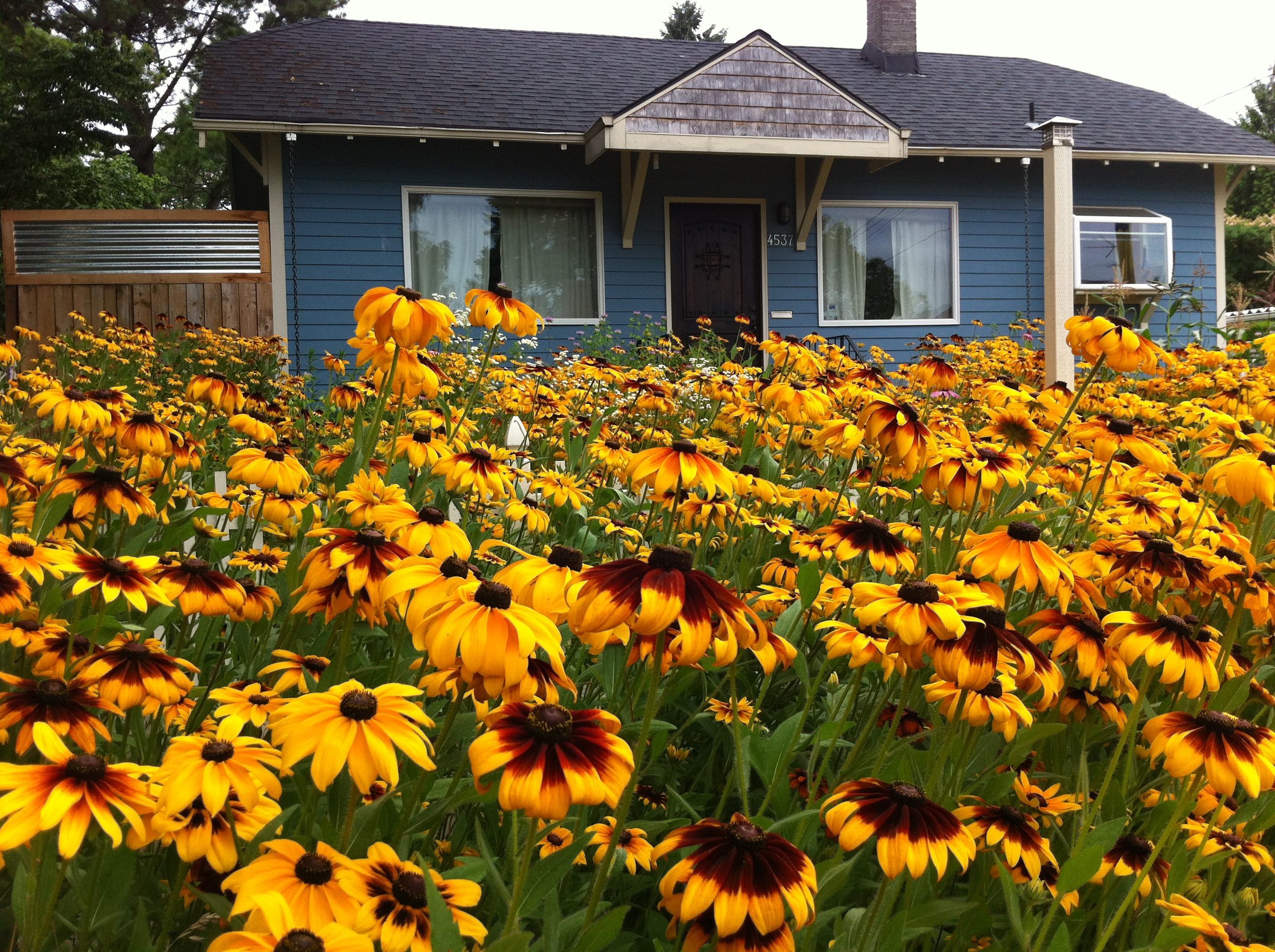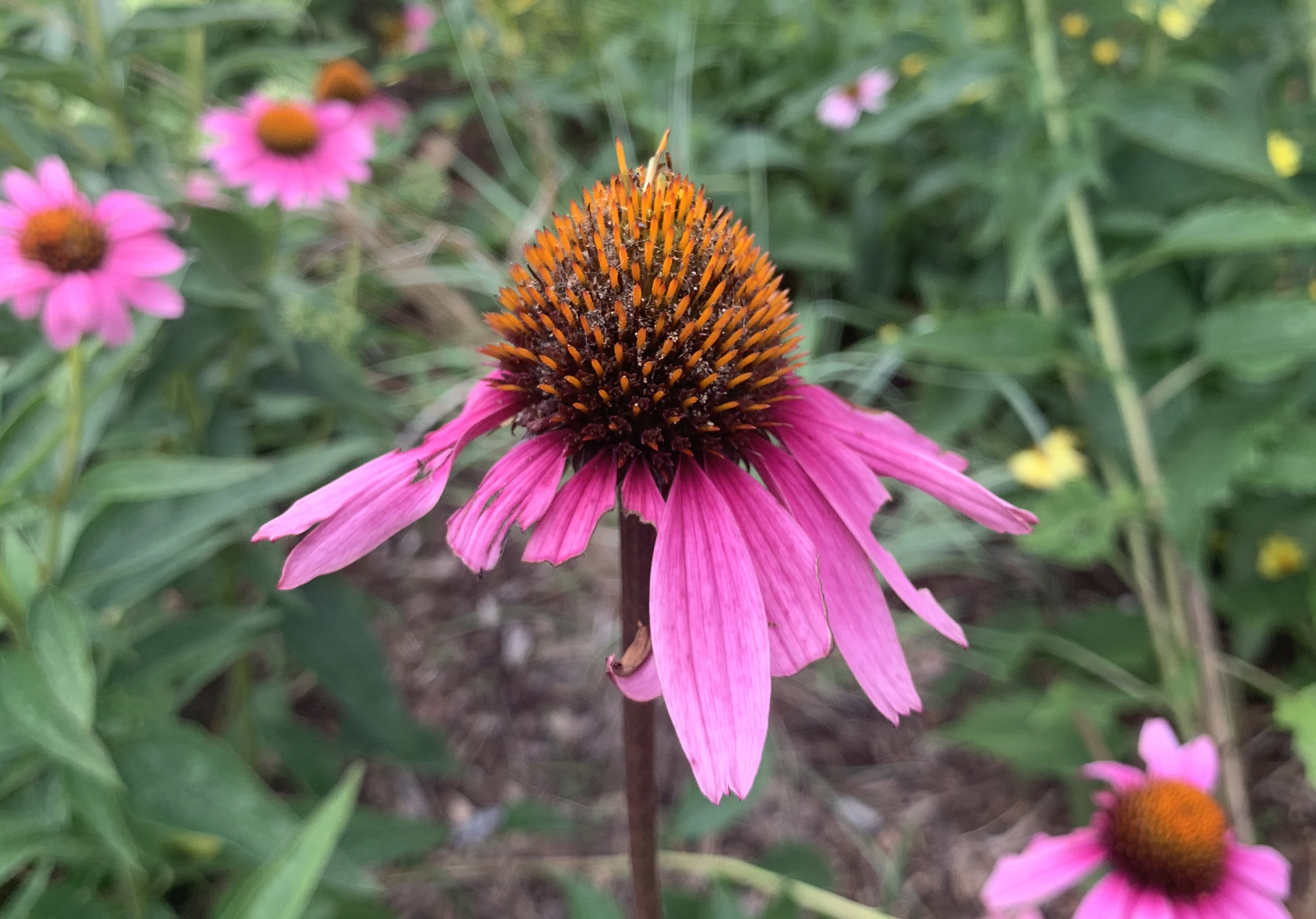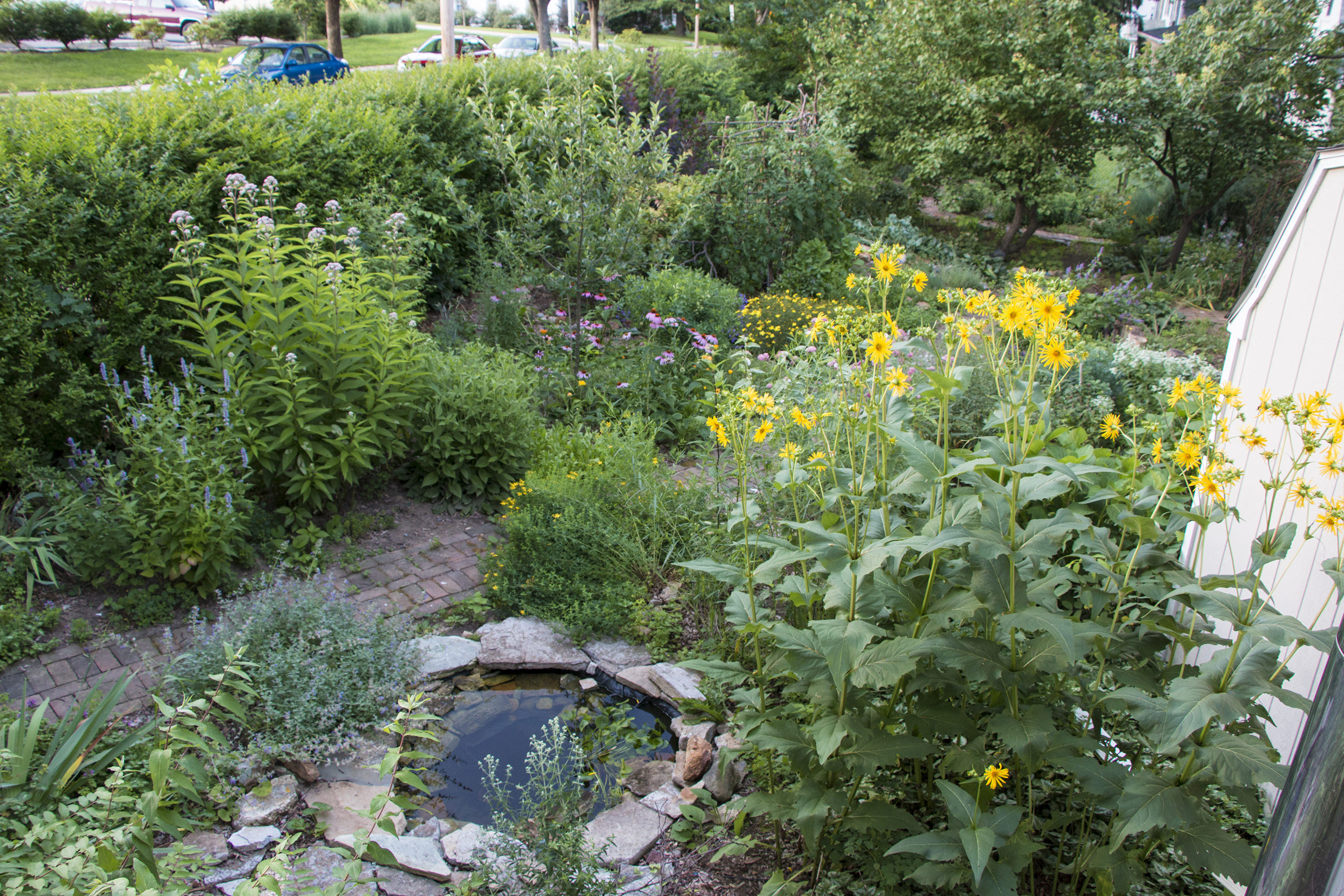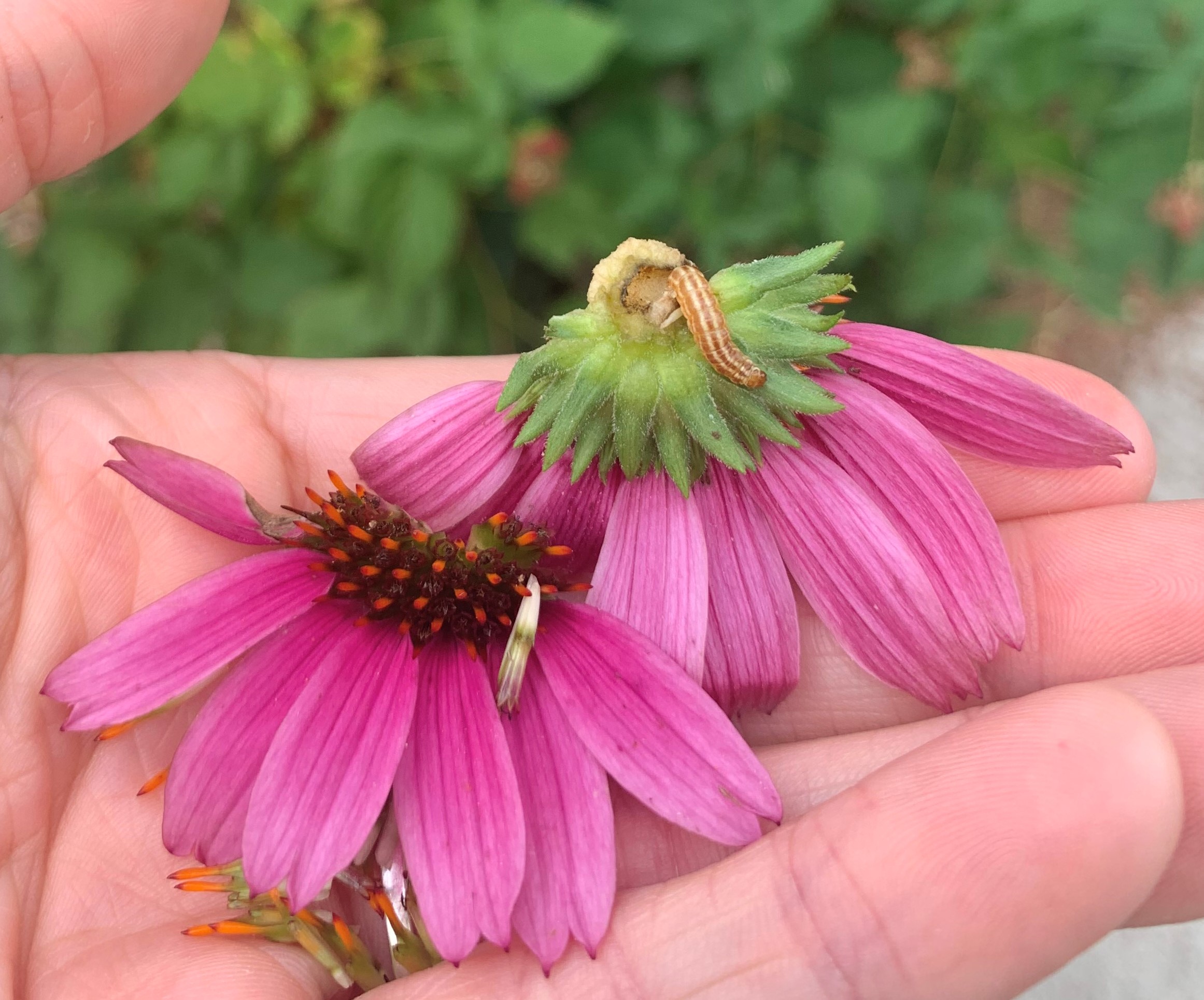One of the most fulfilling aspects of spending most of my time at home over the past few months has been watching the flowers in my yard blossom and buzz with bees, flies, butterflies, hummingbirds, and more. But as I catalogue the many flower visitors buzzing around and enjoying the beautiful array of native plants, I also notice when things go awry, like when I spotted deformed flower heads on my bee balm (Monarda fistulosa) and later on my purple coneflower (Echinacea purpurea). What was going on—and how could I figure out what to do about it?
Building a resilient ecosystem in your yard or garden starts with a foundation of good planning and design: building healthy soils, choosing the right plants for the local conditions, and watering wisely. But problems arise in even the most well-planned gardens. When you’ve put so much care, elbow grease, and resources into building a productive, beautiful space, it can be frustrating to see your plants suffering from an insect pest or disease, and may leave you unsure about whether to intervene, and if so, when and how? What management strategy will work for the particular pest you’re facing, and does that approach fit with the larger goals you have for your garden?
 As any gardener will know, keeping flowers looking beautiful can take some effort. Learning how to identify and understand the natural history of pests is an important step in managing them without chemicals. (Photo: Eric Lee-Mäder.)
As any gardener will know, keeping flowers looking beautiful can take some effort. Learning how to identify and understand the natural history of pests is an important step in managing them without chemicals. (Photo: Eric Lee-Mäder.)
Here’s how you can identify and respond to pests in your home garden and yard in ways that maintain the health and resilience of your local ecosystem.
Before taking any management actions
Monitor and document issues as they arise.
Are you seeing insects, plant damage, or other symptoms? Sometimes the obvious issue is plant damage, and you don’t see insects on the plant. Look closely at and around the plant: do you see evidence of insects having been there, like insect frass, fine webbing, or mining trails in the leaves? What kind of symptoms are you seeing on leaves and flowers: holes cut all the way through, ‘skeletonizing’ of tissue between leaf veins, or dieback of stems or branches? Do you see spotted, browning, or curling leaves?
If you take a closer look, perhaps you’ll see tiny caterpillars or nymphs that you hadn’t seen at first glance. When I looked closely at the flower heads on my bee balm, I saw evidence of insect droppings, so I knew it was likely an insect pest. It took me a few more times before I noticed something moving around in a flower head: a tiny pinkish-greenish caterpillar that camouflaged perfectly with the pink and green flowers.
Soon after, I noticed my purple coneflower had strangely bulging instead of nicely rounded flower heads. Looking closely, I could see dark webbing and frass embedded between the orange bracts of the flower, which indicated that it was likely an insect pest. I couldn’t see the culprit at first, but after pulling a couple of flower heads apart I finally spotted a brown-and-tan striped caterpillar at work.
These days a smartphone can be a very useful gardening tool. Take good photos to help experts identify the specific issue, and keep notes on when the problem developed, what types of symptoms you observe, and how many insects are present or the extent of the damage and symptoms that you see. All of these observations will help in identifying and choosing how to manage the issue.
 The first indication that this purple coneflower had a pest problem was strangely bulging instead of nicely rounded flower heads. A close look revealed dark webbing and frass embedded between the orange bracts of the flower, which indicated that it was likely an insect.
The first indication that this purple coneflower had a pest problem was strangely bulging instead of nicely rounded flower heads. A close look revealed dark webbing and frass embedded between the orange bracts of the flower, which indicated that it was likely an insect.
Get a firm identification on the insect pest or disease.
It’s important to know exactly what you’re dealing with before you make any decisions about management. Remember, just because something is eating your plants doesn’t mean it’s harmful! It might be beneficial in some way: after all, you need caterpillars to have butterflies and moths.
Not everyone knows an entomologist (it sure does come in handy sometimes!), but there are lots of resources to help with identifying insects and plant diseases. A quick Internet search with a description of the insect and damage to the affected plant can be a good start, but be cautious about over-interpreting based on initial search results. For better, more personalized information, contact your local university Cooperative Extension office, Master Gardener hotline, or plant diagnostic laboratory, which can offer expert advice tailored to your local area. Be cautious about identifications and advice you receive from pest control or land care companies, which have an incentive to sell products or services associated with the advice.
There are other options online that may help you figure out what insects are in your yard. BugGuide.net is a great online resource for insect identification, with a community of experts that provide photo identification of insects. If you have an account with Reddit, r/whatsthisbug also has an active community of insect enthusiasts ready to help identify bugs from your photos. These days posting a photo on social media platforms can also result in helpful information.
In my case, I was able to identify both caterpillars through Internet searches that matched the description of the damage as well as the image of the caterpillars that I’d found. I had horsemint caterpillars (Pyrausta signitalis) in the heads of my bee balm and sunflower moth caterpillars (Homoeosoma electellum) feeding on the pollen and immature seeds of my purple coneflower.
The colors of this horsemint caterpillar means it blends perfectly with the bee balm flower head, making it hard to spot. Once it had been seen and identified, and its life cycle understood, a decision could be made on how to manage it. (Photo: Emily May.)
Learn about its biology and life cycle.
Knowing the type of insect or plant disease you have is critical for learning about its life cycle and habitat needs. Effective management of pests is often about removing sources of food or shelter that are specific to that pest.
How and when does it reproduce? Does it have specific host plants? What conditions lead to spikes in pest populations/infection and associated damage? Again, using the Internet to find your state extension service and other trusted sources of information is helpful here.
Decide what level of damage or infestation you’re comfortable with.
This comes back to your goals and intentions. Are you trying to conserve insects and create wildlife habitat? Are you dependent on the fruits and vegetables you’re growing for food or profit? Reflecting on your intentions for the garden can help you decide whether and how it makes sense to intervene.
The damage you’re seeing might just be cosmetic, not a threat to the survival of the plant. In crops, extension service researchers can provide thresholds based on economics: when it makes sense to intervene to prevent yield losses. In home gardens, economic thresholds don’t work as well; generally, we can tolerate more damage because our livelihoods aren’t on the line. And just because a pest is present doesn’t mean it is a problem. It may be present at a level that can be kept in check by beneficial insects and doesn’t threaten the health of your plants.
Thinking about my own yard, I came up with three main goals: 1) to conserve and support the diversity of insects, birds, and other wildlife living around me with native flowering plants; 2) to create a beautiful space that I enjoy watching in the mornings and evenings, coffee in hand; and 3) to manage land with as little effort as possible (yes, that’s right, one of my goals is lazy gardening—why not!). By keeping the conservation goal front and center, it’s easier for me to accept some chaos in the garden and let go of cosmetic imperfections and nibbled leaves, as long as the flowering resources those plants provide are still available for pollinators and other wildlife.
 With an inquisitive mind and thoughtful plant care, even a small garden can offer valuable food and shelter to insects—and provide a beautiful and relaxing place for people. (Photo: Justin Wheeler.)
With an inquisitive mind and thoughtful plant care, even a small garden can offer valuable food and shelter to insects—and provide a beautiful and relaxing place for people. (Photo: Justin Wheeler.)
After you know what you’re dealing with and you’ve decided you want to intervene
Use cultural management options first.
For many diseases and certain larval infestations, sanitation—the removal of infested plant material—is a top choice for reducing the level of damage and breaking the development cycle of that pest or disease. For both my bee balm and purple coneflower, clipping off flower heads that had signs of caterpillar infestation and bagging them up in the garbage (not compost) was my solution for reducing the outbreaks of the Pyrausta and Homoeosoma caterpillars. I didn’t treat the plants, and I didn’t clip off every flower, just the ones that showed signs of heavy damage or lots of frass. After a few rounds of flower head sanitation, I had more flowers start to develop normally without signs of infestation.
For other insect outbreaks, hand picking and squishing or knocking them off with water can be a good first step. Hand picking can be tedious (I’ve spent a lot of late nights picking slugs off of lettuce), but it is deliberate and cautious, saving other wildlife in the garden from harm.
Check to make sure the plant has what it needs for moisture and nutrients. Stressed plants look much worse and have a more difficult time mustering defenses against infection or infestation. For example, blossom end rot in tomatoes, which resembles a fungal disease, is actually the result of calcium deficiency in the plant.
The same resources you may have used to identify the insect pest or plant disease may have suggestions for cultural control options that help break its development cycle. Online cooperative extension resources, such as those found at UC IPM and other land grant universities, often include nonchemical management techniques in their descriptions of insect pests and diseases. Look for these strategies first before considering any chemical control recommendations.
 Caterpillars of the sunflower moth feed on the pollen and immature seeds of purple coneflower. They were discovered by pulling apart misshapen, damaged flower heads. (Photo: Emily May.)
Caterpillars of the sunflower moth feed on the pollen and immature seeds of purple coneflower. They were discovered by pulling apart misshapen, damaged flower heads. (Photo: Emily May.)
Pesticides pose risks to beneficial insects and other wildlife, and should only be considered as a last resort.
The pesticides designed to control unwanted insects rarely distinguish between beneficial insects and those which cause harm. Most home gardens can be managed well without pesticides. If you do decide to use pesticides, use them only when a pest threatens the health of the plant. For more detail on mitigating the risks of pesticides to pollinators and other beneficial insects when pesticides are used, check out our guide to Smarter Pest Management and the Pacific NW Extension publication on reducing bee poisoning from pesticides. Learn more about the toxicity of common pesticides to bees in the searchable Bee Precaution Pesticide Ratings database, as well as in our guide to the toxicity of common organic pesticides.
In my own yard and garden, I’ve made the decision not to use pesticides—including organic pesticides, which are not free from risks. I want a system that is healthy and functional with minimal disturbance. Sometimes this means accepting a certain level of damage and allowing caterpillars, an essential protein source for many young birds, to continue nibbling on my plants. Sometimes I also have to accept that I haven’t planted the right plant for the right place. If there is a plant that is struggling, I do my best to give it what it needs. But I can’t grow everything I want to grow in the local conditions of my small, partially sunny yard. And that’s okay!
The perfectly rounded—and pest free—dome of this purple coneflower provides a good source of nectar to support bees, including this brown-belted bumble bee. (Photo: Emily May.)
To come full circle, building a resilient, healthy ecosystem in your yard or garden that attracts and supports wildlife is about careful observation. Observe the plants in your yard: how they’re doing, what they’re attracting, what conditions of moisture and temperature and soil they respond to. Get observant about the plants in your neighborhood, too. What grows well and buzzes with life in the yards around your neighborhood is a better indication of how well that plant will do in your yard than how good it looks on the day you spot it in the container at the nursery.
Watching your plants and what visits them is part of a continuous process of evaluating what’s working and what isn’t. With all the time I’ve spent watching my plants this summer and making small adjustments to soil fertility, airflow, and plant spacing, I can’t help but think my yard will be in even better shape next year.
Further Reading
Check out our fact sheet on Smarter Pest Management
Read more about our work to reduce pesticide use & impacts
Learn about ecological pest management
Explore the IPI Database to find summaries of research articles on pesticides




